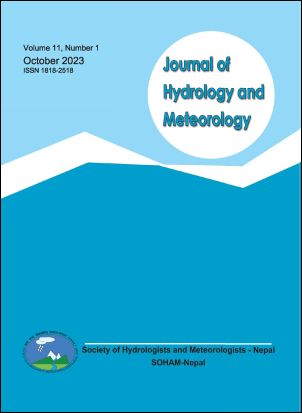Charting the Course to Resilience: Hydrodynamic Modeling for Socio-economic Insights for Flood Risk Management in Nepal’s Ungauged Roshi River Catchment
DOI:
https://doi.org/10.3126/jhm.v11i1.59666Keywords:
Flood Hazard Mapping, Hydrodynamic Model, Scenario-based modeling, Roshi River CatchmentAbstract
Nepal, a Himalayan country with diverse topography, faces significant flood risks yearly. This study focuses on flood hazard mapping and vulnerability assessments for the Roshi River catchment (RRC), situated in the mid-hills of Nepal, by using hydrodynamic modeling and scenario-based approaches. The results obtained from probability distribution methods revealed varying flood magnitudes from 100 m3 /s to 1100 m3 /s. Inundation’s analysis showed plains near the Araniko Highway (AH42) and Panauti Municipality to be high-risk flood-prone areas. Croplands are the most susceptible, while the estimated number of people and buildings at risk varies from 4,000 to 7000 people in 1200 to 2600 buildings. Socio-economic analysis shows that a major portion of the population is from Tamang ethnicity, with relatively lower economic and educational status. Similarly, women in economically and socially disadvantaged communities are particularly at risk, emphasizing the need for increased awareness and support. Proactive flood disaster management strategies are crucial, especially for marginalized and agriculture-dependent communities. The strategically important RRC’s link to key cities, including Kathmandu, demands effective flood control measures. Hydrodynamic modeling with possible scenarios relating to socio-economic aspects can aid decision-making processes from local to central government levels to create a more resilient and disaster-resistant future for Nepal.




